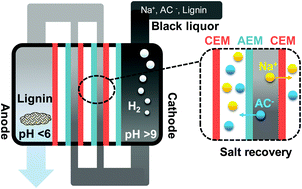Microbial electrochemical treatment of biorefinery black liquor and resource recovery†
Abstract
Biorefineries valorize waste biomass to biofuels and bioproducts, but the associated wastewater treatment is costly and energy-intensive. This study demonstrates that not only the recalcitrant black liquor generated from biorefineries can be treated using a microbial electrochemical process, but also value-added materials including lignin, chemicals, and H2 can be separated to enable resource recovery. A lab scale microbial biomass recovery cell (MBRC) was developed to treat the actual black liquor from the deacetylation and mechanical refining (DMR) process, and the results show that 60.1–73.8% of organics, 52.0–54.6% of salts, and 30.8–49.5% of lignin were removed using different operational modes. Moreover, by utilizing the unique pH gradient generated between the different reactor chambers, tailored recoveries of lignin, chemicals, and H2 were realized for the first time. The recoveries of lignin and salts were up to 61.2 ± 2.7% and 92.2 ± 1.6%, respectively. Ion transfer and organic transformation were further analyzed to understand the reaction mechanisms and improve the system performance.

- This article is part of the themed collection: Green Biorefinery Technologies based on Waste Biomass


 Please wait while we load your content...
Please wait while we load your content...